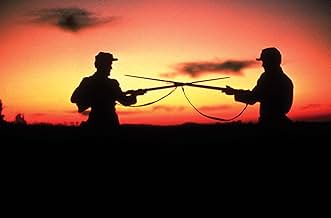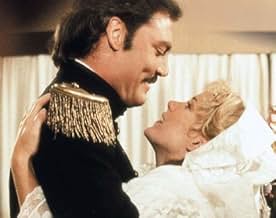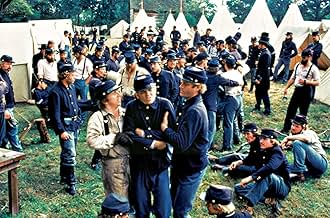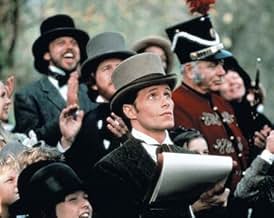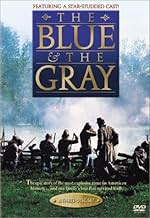Les États-Unis juste avant et pendant la guerre civile, vus à travers les yeux d'un artiste correspondant.Les États-Unis juste avant et pendant la guerre civile, vus à travers les yeux d'un artiste correspondant.Les États-Unis juste avant et pendant la guerre civile, vus à travers les yeux d'un artiste correspondant.
- Nommé pour 4 Primetime Emmys
- 2 victoires et 4 nominations au total
Parcourir les épisodes
Avis à la une
I did not see this movie when it was shown as a mini-series.I happened to like this movie because it gave a simple portrayal of what it might have been like to be a family during this period and having to face the problem of a family that was divided in its loyalties . I thought the makers of this movie followed the history of the period and gave a good presentation of the issues that the people had to deal with at the time. Of course it cannot compare to the recent Civil War Movies or even the Ken Burns series . Given the time that it was made I think it was a good portrayal of the period.
My only fault with the movie was the fact that it seemed to put the fall of Vicksburg after the Gettysburg Address. I did not understand how this was allowed to happen given the fact that it seemed to be based on Bruce Catton's work. Can anyone explain this?
My only fault with the movie was the fact that it seemed to put the fall of Vicksburg after the Gettysburg Address. I did not understand how this was allowed to happen given the fact that it seemed to be based on Bruce Catton's work. Can anyone explain this?
This miniseries shows the war primarily through the eyes of a Virginian who wants to witness history but cannot commit to either side of the conflict. His new-found profession of journalism allows him to participate as a neutral observer. He is surrounded by relatives and friends on both sides, and the miniseries shows events through their eyes as well.
The human side of the war is stressed, and it excellently portrays the toll the conflict took on families.
Many of the subplots are taken from Civil War historian Bruce Catton's final work, "Reflections On The Civil War." However, none of the people in the book, including the real John Geyser, appear in the miniseries. Rather, observations made in the book are woven around the main storyline as supplementary material.
Most of the military aspects of the miniseries are laughable and bear little resemblance to reality. Due to the miniseries being done on a miniseries budget we see none of the grand scale evident in "Gettysburg" or "Glory."
Stacy Keach gives a terrific performance as Jonas Steele, the Federal special operations agent. We see from his performance a little of the decentralized, more personalized ways in which intelligence gathering and other non-standard military operations were conducted in the nineteenth century.
The miniseries ran for over six hours on CBS in 1982, but well over an hour was cut for the two-cassette video release. Get the whole treatment if you can.
The human side of the war is stressed, and it excellently portrays the toll the conflict took on families.
Many of the subplots are taken from Civil War historian Bruce Catton's final work, "Reflections On The Civil War." However, none of the people in the book, including the real John Geyser, appear in the miniseries. Rather, observations made in the book are woven around the main storyline as supplementary material.
Most of the military aspects of the miniseries are laughable and bear little resemblance to reality. Due to the miniseries being done on a miniseries budget we see none of the grand scale evident in "Gettysburg" or "Glory."
Stacy Keach gives a terrific performance as Jonas Steele, the Federal special operations agent. We see from his performance a little of the decentralized, more personalized ways in which intelligence gathering and other non-standard military operations were conducted in the nineteenth century.
The miniseries ran for over six hours on CBS in 1982, but well over an hour was cut for the two-cassette video release. Get the whole treatment if you can.
As others have mentioned, this is a series of recollections of events which may (or may not) have occurred during the American Civil War. It is related from the point of view of a 'neutral' war correspondent, who's talent is for drawing sketches of what he has seen on various battle fields, from Bull Run to Appomattox Ct. House. There is considerable 'time jumping' from one period of the war, to another, which inhibits continuity to some extent. For me the best part of the mini-series was watching Gregory Peck (as Abraham Lincoln) deliver the Gettysburg address. However, we are thrown into that scene without adequate preamble, so even this is diminished from what it could have been.
I am quite an avid amateur Civil War historian, having read many books and watched many TV series (including the excellent PBS series by Ken Burns, and the complete 3 volume set of books on the Civil War by historian Shelby Foote) on the subject. If you are looking for historical accuracy you will be disappointed. If you, on the other hand, are simply looking for a decent dramatization (ala "Gone With the Wind), you will enjoy this series.
The acting by the cast was, in general, C+, with the exception of a few of the notables (Gregory Peck, for one). As my summary states, this is a dramatic romp, so if you keep that in mind and set your sites correspondingly on the low side, you will not be disappointed.
I am quite an avid amateur Civil War historian, having read many books and watched many TV series (including the excellent PBS series by Ken Burns, and the complete 3 volume set of books on the Civil War by historian Shelby Foote) on the subject. If you are looking for historical accuracy you will be disappointed. If you, on the other hand, are simply looking for a decent dramatization (ala "Gone With the Wind), you will enjoy this series.
The acting by the cast was, in general, C+, with the exception of a few of the notables (Gregory Peck, for one). As my summary states, this is a dramatic romp, so if you keep that in mind and set your sites correspondingly on the low side, you will not be disappointed.
I first saw this mini-series while in 5th grade history class as part of our studies on the Civil War, and I thought it was excellent. Many years later, I watched it again after finding a copy of the unabridged version (all 6+ hours of it!). I wasn't sure how it would stand the test of time (both as a 16 year old production and my own view of it, being 16 years older now) and braced myself for disappointment; however, I was very pleasantly surprised. The movie is as well done as I remembered it.
It's an engrossing movie that gives an honest, frank look at the inherent moral ambiguity of war, as well as the additional consequences of the Civil War, where "brother fought brother". Although the movie certainly takes dramatic license (the main character, a young Southerner who relocates to the north after becoming disillusioned with the cruel treatment of slaves, ends up stumbling across his staunchly pro-Confederate siblings as if they're all wandering around in the same town instead of an entire country!), you can see that the film makers took great pains to portray as many perspectives as possible, to show that each and every person involved in the war was human, with their own thoughts and feelings. I'm certainly no Civil War expert, but I thought it was a very balanced portrait. What's more amazing is that the mini rarely drags despite sometimes taking a leisurely pace during its 6 hour run-time. Although we all know how the movie with ultimately end, it keeps you interested in the lives of all the characters it introduces. I thought Stacy Keach did a particularly good job despite a few hammy lines. This mini-series should definitely be on any must-see list of war films.
It's an engrossing movie that gives an honest, frank look at the inherent moral ambiguity of war, as well as the additional consequences of the Civil War, where "brother fought brother". Although the movie certainly takes dramatic license (the main character, a young Southerner who relocates to the north after becoming disillusioned with the cruel treatment of slaves, ends up stumbling across his staunchly pro-Confederate siblings as if they're all wandering around in the same town instead of an entire country!), you can see that the film makers took great pains to portray as many perspectives as possible, to show that each and every person involved in the war was human, with their own thoughts and feelings. I'm certainly no Civil War expert, but I thought it was a very balanced portrait. What's more amazing is that the mini rarely drags despite sometimes taking a leisurely pace during its 6 hour run-time. Although we all know how the movie with ultimately end, it keeps you interested in the lives of all the characters it introduces. I thought Stacy Keach did a particularly good job despite a few hammy lines. This mini-series should definitely be on any must-see list of war films.
I'm not going to nitpick this film because the wrong number of buttons are on a Civil War jacket nor am I going to criticize the fact that certain battles are presented out of chronological sequence, as some others have already pointed out.
But taken as a Civil War drama, THE BLUE AND THE GRAY ranks with the very best movies made about this era of American history and all of the performances are splendid. The human drama, both on the home front before the war and during the various battles, is portrayed very realistically, as are the graphic battle scenes.
The cast assembled does a wonderful job with characters that come alive. GREGORY PECK does well as Abraham Lincoln, although his make-up is a bit disconcerting and he was a bit too mature to play the role in the first place. But STACY KEACH and JOHN HAMMOND carry much of the film as the two leading characters who witness various aspects of the Civil War, seen through their eyes and experiences, and they are excellent.
The supporting cast includes vivid performances from LLOYD BRIDGES, COLLEEN DEWHURST, RORY CALHOUN, GERALDINE PAGE, RIP TORN, STERLING HAYDEN, DIANE BAKER. BRIAN KERWIN is excellent as the Hale brother facing battle for the first time, and the sequence with the balloon to observe the enemy from the air is full of tight suspense.
It may not be a perfect history lesson, but it is photographed beautifully in color (all of it filmed in Arkansas), has a fine musical score and is well worth the time it takes to unwind a very compelling story with characters any viewer can relate to.
I consider it one of the finest made-for-TV miniseries ever made.
But taken as a Civil War drama, THE BLUE AND THE GRAY ranks with the very best movies made about this era of American history and all of the performances are splendid. The human drama, both on the home front before the war and during the various battles, is portrayed very realistically, as are the graphic battle scenes.
The cast assembled does a wonderful job with characters that come alive. GREGORY PECK does well as Abraham Lincoln, although his make-up is a bit disconcerting and he was a bit too mature to play the role in the first place. But STACY KEACH and JOHN HAMMOND carry much of the film as the two leading characters who witness various aspects of the Civil War, seen through their eyes and experiences, and they are excellent.
The supporting cast includes vivid performances from LLOYD BRIDGES, COLLEEN DEWHURST, RORY CALHOUN, GERALDINE PAGE, RIP TORN, STERLING HAYDEN, DIANE BAKER. BRIAN KERWIN is excellent as the Hale brother facing battle for the first time, and the sequence with the balloon to observe the enemy from the air is full of tight suspense.
It may not be a perfect history lesson, but it is photographed beautifully in color (all of it filmed in Arkansas), has a fine musical score and is well worth the time it takes to unwind a very compelling story with characters any viewer can relate to.
I consider it one of the finest made-for-TV miniseries ever made.
Le saviez-vous
- AnecdotesSome filming took place at Prairie Grove Battlefield State Park in Arkansas. The film crew built a false side onto a historic building there, then blew it off for a special effect, assuring the State park officials that no harm would come to the building. The explosion was larger than promised, damaging the historic house's structure.
- GaffesWhen John Brown is hanged for the uprising at Harper's Ferry, the apple trees are in full blossom. John Brown was hanged on 2 December 1859.
- Citations
Abraham Lincoln: It's well known that the more a man speaks, the less he's understood.
- ConnexionsReferenced in Saturday Night Live: Drew Barrymore/Squeeze (1982)
- Bandes originalesRock of Ages
Lyrics by Augustus Montague Toplady (as Augustus M. Toplady)
Music by Thomas Hastings
Meilleurs choix
Connectez-vous pour évaluer et suivre la liste de favoris afin de recevoir des recommandations personnalisées
- How many seasons does The Blue and the Gray have?Alimenté par Alexa
Détails
- Date de sortie
- Pays d’origine
- Langue
- Aussi connu sous le nom de
- Die Blauen und die Grauen
- Lieux de tournage
- Sociétés de production
- Voir plus de crédits d'entreprise sur IMDbPro
Contribuer à cette page
Suggérer une modification ou ajouter du contenu manquant

Lacune principale
By what name was The Blue and the Gray (1982) officially released in India in English?
Répondre


